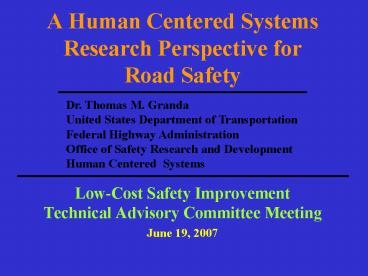A Human Centered Systems Research Perspective for Road Safety - PowerPoint PPT Presentation
1 / 23
Title: A Human Centered Systems Research Perspective for Road Safety
1
A Human Centered SystemsResearch Perspective
forRoad Safety
Dr. Thomas M. Granda United States Department of
Transportation Federal Highway Administration Offi
ce of Safety Research and Development Human
Centered Systems
- Low-Cost Safety Improvement Technical Advisory
Committee Meeting - June 19, 2007
2
Overview
Picture 1
- Introduction
- Description of Human Centered Systems laboratory
facilities - Description of nature and scope of research
- Selected areas/studies of behavioral research
Picture 2
Picture 3
Picture 4
3
Human Error Crash Causation
K. Rumar, 1985
4
Turner-Fairbank Highway Research Center HCS
Research Capabilities
Picture 1
Sign Simulator Field Research Vehicle Field- Tes
ts, Validation
Picture 2
- Desktop
- Simulator
- Highway
- Driving
- Simulator
- (HDS)
- Photometric
- Visibility
- Laboratory
Picture 3
Picture 4
Picture 5
Picture 6
5
Sign Simulator
- Determine meaning of signage
- Obtain initial estimates of recognition distance
6
Low Fidelity Simulation
Field Data Collection
Picture 2
Picture 1
Picture 3
Picture 4
7
Field Research Vehicle
- 1999 Saturn SL-1
- Data collection system
- 4 cameras
- Video quad unit
- 3 axis digital accelerometer
- GPS receiver
- Inverter for 120v AC power
- Laptop computer for data storage
- Analog and digital video recording
Picture 1
Picture 2
Picture 3
8
Highway Driving Simulator
- Saturn Car cab with 3 df motion base
- 270 degree field of view
- Rear and side view mirrors
- cluster-based PC workstation environment
- GeForce NVidea 7900 GTX Pro graphics cards
- In-house programming using open source code in a
Linux Environment
9
Proper Fit of Research Tools Activities
Research tools proceeds from simple on the left
to complex on the right SQ Survey/Questionnaire
, TA Task Analysis, CM Computer Model, PT
Part Task Simulator, LF Low Fidelity
Simulator, HF High Fidelity Simulator, FT
Field Test
10
HCS Program Areas
- Intersections
- Warning to potential crash victims
- Diverging Diamond Interchange
- Pedestrians Bicycles
- Speed Management
- Visibility
- Operations
- Transportation Management Pooled Fund Study
- Traffic Control Device Pooled Fund Study
Picture 1
Picture 2
Picture 3
11
Intersections Infrastructure Based Red-Light
Violator Warning
- Test 3 warnings in HDS
- Assess driver response to unexpected warning
- 64 of drivers responded in a way that would
prevent collision with a red-light violator
12
Intersections Field Validation ofRed-Light
Violator Warning
- Assessed unexpected warning on Smart Road
- 90 of drivers stop given 2.7 sec. advance
warning - Need to assess driver response when subject
vehicle is part of a platoon
13
IntersectionsRed-Light Violator Warning to
Drivers in Platoons
- Four platoon scenarios
- Lead vehicle brakes
- Lead vehicle does not react to warning
- Vehicle following participant
- No other vehicles present
- Three warning distances (assuming 45 mph)
- 180 ft (2.7 s,)
- 142.5 ft (2.2 s)
- 105 ft (1.6 s)
14
Pedestrian Exposure to Risk
- Problem
- Crash statistics must be adjusted
- for exposure
- Risk Crashes / Exposure
- Procedure
- Conducted literature review of 100 papers
- Analyzed previously suggested exposure metrics
- Recommended new metric hundred million
pedestrian feet of roadway traveled - Tested feasibility of collecting data with new
metric at 7 sites in Washington, DC
15
Pedestrian Exposure to Risk Sampling Sites
- Calm stop-controlled intersection
- Metro stop mid-block crossing
- Dead-end street with car repairs, etc.
- Busy entertainment area intersection
- Busy Metro stop intersection
- Shopping mall parking lot
- Residential street with many driveways
16
Pedestrian Exposure to Risk Findings
- It is feasible to collect data using proposed
metric - 8 hour samples at 7 sites in one city yielded
total of 1.13 million pedestrian feet of roadway
traveled - Developed special measurement techniques for
driveways and parking lots - Proposed metric has promise to serve as
denominator of pedestrian risk equation
17
Pedestrian Exposure to RiskNext Research Steps
- Collect more samples in a single city
- Test collecting samples in a rural area
- Generalize to entire city or area
- Employ combination of empirical sampling and
statistical modeling - Generalize to exposure for entire nation
- Develop validation and update procedures
18
Pavement Markings for Speed Reduction Research
Goals
Picture 2
- Determine a low-cost pavement marking treatment
with a high probability of success - Determine the effectiveness of the marking
through a field evaluation at three different
locations
Picture 1
Picture 3
19
Pavement Markings for Speed Reduction Results
- Peripheral Transverse Lines as a Pavement Marking
Pattern have the ability to significantly reduce
vehicle speeds (4 mph reduction in average speeds
in New York and 5 mph reduction in Mississippi) - Appear to be most effective with unfamiliar
drivers and in situations where roadway geometry
requires a reduction in speed
20
Colors for Transponder-Controlled Tollbooth
Lanes Research Goal
- Purpose of study
- Develop a set of sign color recommendations for
Transponder-Controlled Tollbooth Lanes - Background Color
- Font Color
- Overlay Color with Pictographs
Picture 1
Picture 2
Picture 3
Picture 4
Picture 5
21
Colors for Transponder-Controlled Tollbooth
Lanes Results
Consistent with current practice, signs with a
green background and white font was easiest to
see at larger distances by research participants.
22
Human Centered Systems Perspective
Picture 2
Picture 1
Picture 4
Picture 3
23
Questions
- View our Website at www.tfhrc.gov
- Contact Tom Granda
- 202-493-3365
- thomas.granda_at_dot.gov































